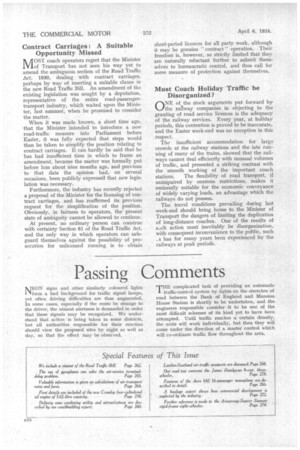Passing Comments 1.40E0N signs and other similarly coloured lights
Page 36

Page 37

If you've noticed an error in this article please click here to report it so we can fix it.
form a bad background for traffic signal lamps, yet often driving difficulties are thus augmented. In some cases, especially if the route be strange to the driver, the utmost alertness is demanded in order that these signals may be recognized. We understand that action is being taken in some districts, but all authorities responsible for their erection should view the proposed sites by night as well as day, so that the effect may be observed.
THE complicated task of providing an automatic traffic-control system by lights on the stretches of road between the Bank of England and Mansion House Station is shortly to be undertaken, and the engineers responsible consider it to be one of the most difficult schemes of its kind yet to have been attempted. Until traffic reaches a certain density, the units will work individually, but then they will come under the direction of a master control which will co-ordinate traffic flow throughout the area. QNE of the greatest problems in the construction of the North Circular Road, London, has been the building of an aqueduct to carry the Grand Union Canal over a lowered roadway, near Stonebridg-e. The aqueduct was actually built without interrupting the canal traffic—a remarkable feat of engineering.
0" great source of danger on main roads that pass
through populated districts is the parking of vehicles outside shops and houses. Not only does their presence diminish the effective width, but it also obstructs the. driver's view of the pavement and the pedestrian's view of the road. Occasionally longsighted authorities have provided parallel roads at the sides of the main thoroughfares for slow local traffic and parking, but these are the exception rather than the rule. Wherever shops and houses are being built up alongside new highways, adequate space should be allowed for this purpose.
S°IVIE confusion has arisen as to the date, April 1, after which, according to the Road Traffic Bill, a would-be driver must satisfy the licensing authority that he has passed the prescribed test, or has previously held a licence. As the Bill is not an Act, and is. therefore, not yet law, there cannot yet be any restriction, and after inquiry we are able, with reserve, to state that a person obtaining his first driving licence after April 1 and before the Bill has passed, Can continue to drive under this licence without a test until it has to be renewed, when he will be required to show his ability to drive.
THE new low-built direction signs afford a tempt
ing bait to local gymnasts. Such misuse contributes neither to their durability nor 'legibility. Whilst not wishing to discourage muscular development on the part of the country's manhood, we deplore that it should be thus acquired. A preven• five might be the sharp bevelling of the top edges of the signpost arms.
ARGUMENTS for and against tipping gears and moving floors are numerous. Each has certain advantages over the other. Tare weight haying become of first importance, lightness of such equipmeni obviously gains prominence, but, less obviously, the choice affects the weight of the original chassis. The argument in this case favours the moving floor, for a lightly built chassis, which it might be unwise to equip with tipping gear, may be afforded enhanced nsefulness if provided with a body having a moving floor, which, although possibly heavier, imposes rather less severe stresses on the frame.
AGREAT deal has• been said about regrinding or relining cylinders. Mr. C. W. Brett, managing director of Barimar, Ltd., points out, however, that there are cases in which a cylinder block is totally unsuited for the fitting of liners, irrespective of type. This applies particularly where the valve seatings are already very close, to the bores, and any further removal of metal would almost certainly lead to cracks across the narrow bridges of metal. In such cases, regriaring is better. Only long experience enables one to .determine which process is advisable.




































































































